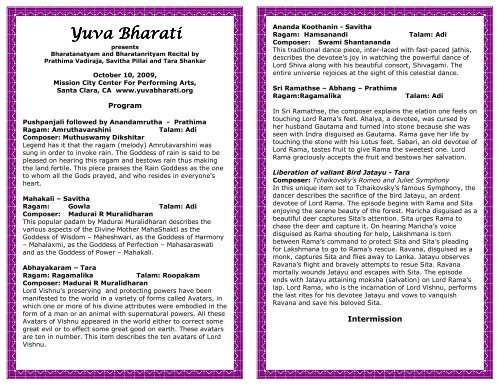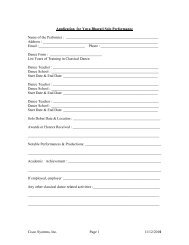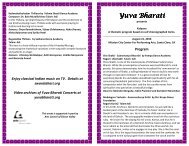You also want an ePaper? Increase the reach of your titles
YUMPU automatically turns print PDFs into web optimized ePapers that Google loves.
<strong>Yuva</strong> <strong>Yuva</strong> <strong>Bharati</strong><br />
<strong>Bharati</strong><br />
presents<br />
Bharatanatyam and Bharatanrityam Recital by<br />
Prathima Vadiraja, <strong>Savitha</strong> Pillai and Tara Shankar<br />
October 10, 2009,<br />
Mission City Center For Performing Arts,<br />
Santa Clara, CA www.yuvabharati.org<br />
Program<br />
Pushpanjali followed by Anandamrutha - Prathima<br />
Ragam: Amruthavarshini Talam: Adi<br />
Composer: Muthuswamy Dikshitar<br />
Legend has it that the ragam (melody) Amrutavarshini was<br />
sung in order to invoke rain. The Goddess of rain is said to be<br />
pleased on hearing this ragam and bestows rain thus making<br />
the land fertile. This piece praises the Rain Goddess as the one<br />
to whom all the Gods prayed, and who resides in everyone's<br />
heart.<br />
Mahakali – <strong>Savitha</strong><br />
Ragam: Gowla Talam: Adi<br />
Composer: Madurai R Muralidharan<br />
This popular padam by Madurai Muralidharan describes the<br />
various aspects of the Divine Mother MahaShakti as the<br />
Goddess of Wisdom – Maheshwari, as the Goddess of Harmony<br />
– Mahalaxmi, as the Goddess of Perfection – Mahasaraswati<br />
and as the Goddess of Power – Mahakali.<br />
Abhayakaram – Tara<br />
Ragam: Ragamalika Talam: Roopakam<br />
Composer: Madurai R Muralidharan<br />
Lord Vishnu's preserving and protecting powers have been<br />
manifested to the world in a variety of forms called Avatars, in<br />
which one or more of his divine attributes were embodied in the<br />
form of a man or an animal with supernatural powers. All these<br />
Avatars of Vishnu appeared in the world either to correct some<br />
great evil or to effect some great good on earth. These avatars<br />
are ten in number. This item describes the ten avatars of Lord<br />
Vishnu.<br />
Ananda Koothanin - <strong>Savitha</strong><br />
Ragam: Hamsanandi Talam: Adi<br />
Composer: Swami Shantananda<br />
This traditional dance piece, inter-laced with fast-paced jathis,<br />
describes the devotee’s joy in watching the powerful dance of<br />
Lord Shiva along with his beautiful consort, Shivagami. The<br />
entire universe rejoices at the sight of this celestial dance.<br />
Sri Ramathse – Abhang – Prathima<br />
Ragam:Ragamalika Talam: Adi<br />
In Sri Ramathse, the composer explains the elation one feels on<br />
touching Lord Rama's feet. Ahalya, a devotee, was cursed by<br />
her husband Gautama and turned into stone because she was<br />
seen with Indra disguised as Gautama. Rama gave her life by<br />
touching the stone with his Lotus feet. Sabari, an old devotee of<br />
Lord Rama, tastes fruit to give Rama the sweetest one. Lord<br />
Rama graciously accepts the fruit and bestows her salvation.<br />
Liberation of valiant Bird Jatayu - Tara<br />
Composer: Tchaikovsky’s Romeo and Juliet Symphony<br />
In this unique item set to Tchaikovsky’s famous Symphony, the<br />
dancer describes the sacrifice of the bird Jatayu, an ardent<br />
devotee of Lord Rama. The episode begins with Rama and Sita<br />
enjoying the serene beauty of the forest. Maricha disguised as a<br />
beautiful deer captures Sita’s attention. Sita urges Rama to<br />
chase the deer and capture it. On hearing Maricha’s voice<br />
disguised as Rama shouting for help, Lakshmana is torn<br />
between Rama’s command to protect Sita and Sita’s pleading<br />
for Lakshmana to go to Rama’s rescue. Ravana, disguised as a<br />
monk, captures Sita and flies away to Lanka. Jatayu observes<br />
Ravana’s flight and bravely attempts to resue Sita. Ravana<br />
mortally wounds Jatayu and escapes with Sita. The episode<br />
ends with Jatayu attaining moksha (salvation) on Lord Rama’s<br />
lap. Lord Rama, who is the incarnation of Lord Vishnu, performs<br />
the last rites for his devotee Jatayu and vows to vanquish<br />
Ravana and save his beloved Sita.<br />
Intermission
Idathu Padam – Prathima<br />
Ragam: Khamas Talam: Adi<br />
Composer: Papanasam Sivan<br />
Idathu Padam is in praise of Lord Nataraja or Shiva as the<br />
cosmic dancer. He is the one who dances with his left leg<br />
raised. His form is adorned with serpents that sway in unison<br />
and with garments of tiger skin. He is worshipped by the sages<br />
who watch in awe as he dances. The bells on his anklets jingle<br />
and in his matted locks, the moon shines. Lord Vishnu plays the<br />
mridangam for Nataraja as he dances in the temple of<br />
Chidambaram.<br />
Ujjaini – <strong>Savitha</strong><br />
Ragam: Kalyani Talam: Adi<br />
Composer: <strong>Bharati</strong>yar<br />
Ujjayini is a melidious keerthanam describing the victorious,<br />
ever-beautiful Goddess Shakti, the consort of Lord Shiva. It<br />
goes on to describe her various avatars and how they combine<br />
to form the divine power that protects the universe.<br />
Dhrupad - Tara<br />
Ragam: Poorvi Talam: Roopakam<br />
Dhrupad is an ancient style of Hindustani classical music. This<br />
item includes pure musical notes (swaras) and poetic verses<br />
(sahitya). It describes the beauty of the Sapta Swaras - seven<br />
sacred musical notes: Sa, Re, Ga, Ma, Pa, Da, Ni. The Sapta<br />
Swaras are inspired by sounds of birds & animals. Shadja<br />
(Peacock), Rishaba (Ox) , Gandhara (Goat), Madyama<br />
(Krouncha bird) , Panchama (Cuckoo), Dhaivata (Horse) &<br />
Nishada (Elephant).<br />
Dasavataram – <strong>Savitha</strong><br />
Ragamalika & Talamalika<br />
Dasavataram is a fast-paced item that depicts the 10<br />
incarnations of Lord Vishnu to save the humanity from<br />
monstrous demons.<br />
Thillana– Prathima<br />
Ragam Thillang Talam: Adi<br />
Composer: Lalgudi G. Jayaraman<br />
<strong>Savitha</strong> Pillai<br />
<strong>Savitha</strong> is a Bharatanatyam and Mohiniattam dancer, having<br />
started her Bharatanatyam training under Smt. Radha<br />
Chandran of Natya Kala Mandir in Mumbai. After her<br />
Arangetram in 1991, she performed at various venues in India<br />
including the Guruvayoor temple in Kerala. Her Mohiniattam<br />
initiation was under Smt. Geeta ijayshankar, with whom she<br />
performed for several years before moving to the US.<br />
In the US, <strong>Savitha</strong> resumed her practice at Smt. Shreelata<br />
Suresh’s Vishwa Shanti Dance Academy, San Mateo, CA. As<br />
part of the academy, she has performed at the San Francisco<br />
Ethnic Dance Festival and the Spring Dance Inspiration at the<br />
Fort Mason Center, San Francisco. For the past couple of years,<br />
<strong>Savitha</strong> has also been teaching at the Vishwa Shanti Academy.<br />
Tara Shankar<br />
Tara has trained rigorously in the theory and practice of<br />
"Bharata Nrityam" under her Guru and Mother Smt. Radhika<br />
Shankar. Tara gave her Bharata Nrityam Arangetram in sep'<br />
2004. She danced at the Nritya Navaratri Mahotsavam held at<br />
Naradana Gana Sabha. Tara performed the “Art of Karanas”<br />
with her mother in March 2007. Tara has performed with her<br />
mother at Divya Nama Anjali, a benefit concert for the<br />
Livermore Temple. She also performed for Bhavan Shri Satya<br />
Sai Baba's 80th B'day celebrations. She has participated in<br />
Kalpana program organized by <strong>Yuva</strong> <strong>Bharati</strong>.<br />
Tara Shankar is pursuing political science at UC Irvine. She<br />
learns classical Karnatic music with Guru. Asha Ramesh. She is<br />
a <strong>Yuva</strong> kendra graduate at the Chinmaya Bala Vihar. Tara is the<br />
co-captain of the UCI A cappella group, Andaaz and a member<br />
of the concert choir group at UC Irvine.<br />
Prathima Vadiraja<br />
Prathima has been undergoing training in Bharathanatyam for<br />
10 years now. She trained under Thiru. A.Lakshman, artistic<br />
director of Nritya Lakshana in Chennai and is continuing her<br />
training under Smt. Vidhya Subramanian, artistic director of<br />
Lasya in Cupertino. Some of her notable performances, after<br />
her arangetram in 2000, were at the Natyanjali festival in<br />
Chidambaram, International dance festival in Chennai, <strong>Yuva</strong><br />
<strong>Bharati</strong>'s Kalpana and the Storytime festival in San Francisco.










